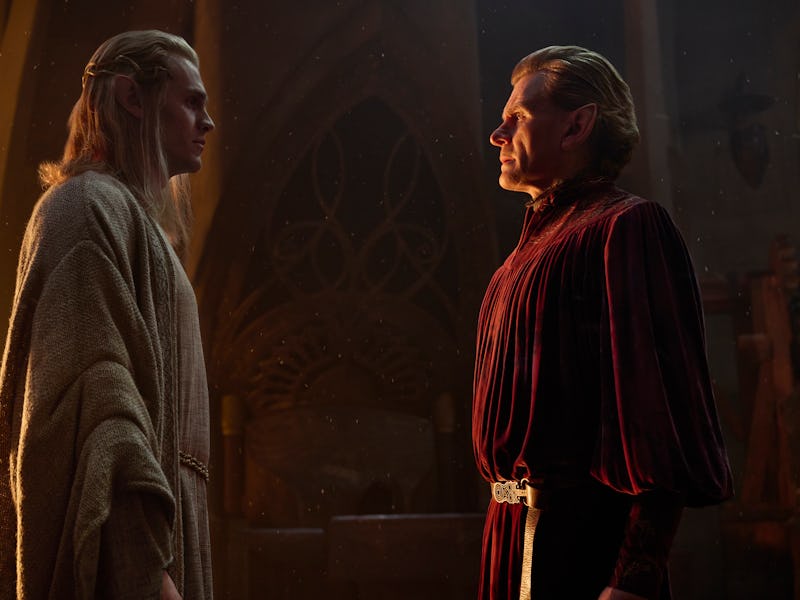Rings of Power Just Broke Tolkien Canon — And Then Fixed It
Let’s talk about that dual cliffhanger.

Overwhelmingly, if you're a fan of The Lord of the Rings and of J.R.R. Tolkien’s unforgettable world of Middle-earth in general, The Rings of Power Season 2 will likely feel like a treat. While Season 1 is great, it danced around some canonical events. Meanwhile, Season 2 is leaning a bit harder toward the cool stuff we want to see from the Second Age, and in doing so, is depicting characters and events from the lore of Lord of the Rings in ways that are generally more comforting and familiar than not.
To put it another way, the only thing you really need to remember from Season 1 of The Rings of Power is that Sauron pretended to be a human and got the elves to start making some rings. But, if you’re a stickler for the true lore, his “fair form” in Season 1 was the human known as Halbrand, who was totally invented for the series, while his new guise in Season 2 is Annatar, an Elf, who is 100 percent from the books. This dichotomy is a good microcosm for comparing all of Rings of Power Season 2 to the J.R.R. Tolkien source material; some of it matches up great, and other parts are a bit wonkier.
This brings us to the ending of Season 2, Episode 3 of The Rings of Power. Prime Video started off the season season with a three-episode premiere, the last of which ends on a dual cliffhanger. This ending both breaks Lord of the Rings canon, but also fixes another part of canon simultaneously.
Spoilers ahead for the first three episodes of The Rings of Power Season 2.
The Eagle favors what now?
Tar-Míriel (Cynthia Addai-Robinson) tries to keep her throne in The Rings of Power.
At the end of the third episode, the series spends a good deal of time in the kingdom of Númenor, culminating in a surprising twist for Queen Regent Míriel (Cynthia Addai-Robinson). After her subjects learn that she has been consulting a palantíri (sometimes known as a seeing stone) everyone freaks out, putting her official rule into question. When Inverse spoke to Addai-Robinson recently, she pointed out that in Tolkien’s writings, “[Míriel] is written about, but it’s a sketch of a character.”
And so, in Rings of Power, that sketch is getting filled in a fairly robust way, but perhaps not the way even hardcore Tolkien fans would expect. According to the appendices of Return of the King, she was forced to marry her cousin Pharazôn (Trystan Gravelle) and rule over Númenor with him. But that’s not what happens in this episode.
Instead, after the commotion of Míriel getting accused of using a palantíri, a giant Eagle arrives, which seems to signal to the people that “the Eagle favors Pharazôn.” Let’s be clear: This exact moment is a deviation from the established canon. Eventually, Pharazôn will be partially responsible for the downfall of Númenor, mostly because he’s destined to bring Sauron to his kingdom as a supposed prisoner. Will we see this actually come to pass later this season? Maybe. But for now, the rejection of Míriel’s power in favor of Pharazôn — and because of an eagle — is new narrative territory.
The Dwarves get their Rings
King Durin III (Peter Mullan) is ready for his own Rings.
While The Rings of Power is messing with the backstory of Númenor, it is simultaneously sticking very close to established lore when it comes to how Annatar (Charlie Vickers) and Celebrimbor (Charles Edwards) are doling out the Rings to the various races of Middle-earth.
In Season 1, we had Sauron’s human guise of Halbrand helping to make the first two Elf Rings. But now, in the final moments of the third episode of Season 3, we see King Durin III (Peter Mullan) of the Dwarves coming to the Elves, waiting for their own Rings. We know there will be seven Rings of Power for the Dwarf Lords, and the very end of Episode 3 depicts the very moment this will actually happen.
Unlike the Elf rings, which all have names and functions, little is known about the powers and uses of the Dwarves’ rings. But clearly, that is all about to change. Sauron is wearing his Annatar disguise well, and making the rings that will create the ultimate deception of the free peoples of Middle-earth. With the Elves wearing their three rings in the first episode, and the Dwarves about to rock their rings in the third; it seems that The Rings of Power is finally living up to its name.